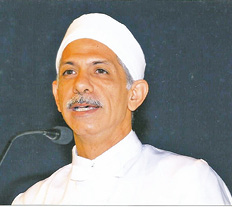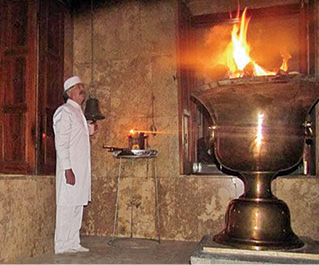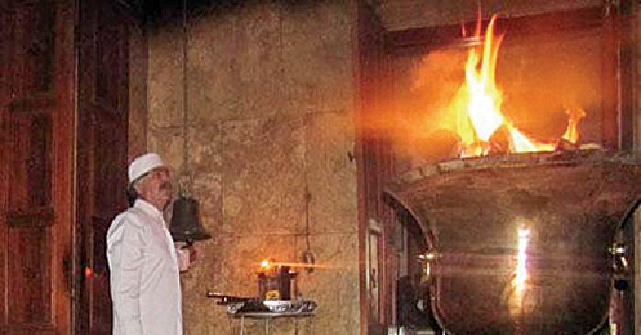 PT: Tell us about the origin of ‘Gehs’.
PT: Tell us about the origin of ‘Gehs’.
Er. Karanjia: The word ‘Gah’ or ‘Geh’ originates from the Pahlavi language, meaning ‘time, period or place’. Time is a very important concept in the Zoroastrian religion. The world was created as a fixed period of time from endless time. To be connected to God it is necessary to connect through time. Hence, Zoroastrian religion divides time as follows: Endless Time (zaravaana akarana); Specific Time (thwaasha khadhaata); Years (ayara); Months (maah); Gahambars/Days (asnya/roj); and periods of days (Geh).
The division of a day into Gehs is ancient. From the Gathas, we know that in the time of prophet, Zarathushtra, there were originally at least 3 divisions of the day – morning (Usha), mid-day (Arem-Pithwa) and night (Khshapa). We are told, in the Hom Yasht that prophet Zarathushtra prayed to Hom Yazad in the Havan Geh (haavanim ratum).
PT: Why are there 5 Gehs and what is the importance of the pre-Geh Boi ritual and fuelling of Aatash Padshah when each Geh changes, as also the Baj ritual?
Er. Karanjia: The five Gehs were fixed keeping in mind certain fixed points in the 24 hours day – namely sunrise, mid-day, sunset and mid-night. Boi ritual and Kasti ritual have to be periodically performed to feed the fire and the human body respectively, with spiritual energy, every few hours. The Boi also regulates the time of feeding the fire which requires fuel to keep burning. It is necessary to perform Baj or Yasna ritual before giving Boi of the Atash Behram in order to prepare the Mobed saheb himself for the onerous task. However it is not necessary to perform it before each gah. One Baj/Yasna ritual performed can last for several Gehs.
 PT: What is the meaning of Gehs – Havan, Rapithwan, Uzerin, Aiwisruthrem and Ushahin? Why are they in this order?
PT: What is the meaning of Gehs – Havan, Rapithwan, Uzerin, Aiwisruthrem and Ushahin? Why are they in this order?
Er. Karanjia: The names of the five Gehs are originally from the Avesta language. Havan means ‘time of pounding Haoma’, Rapithwin means ‘half part of the day’, Uziran means ‘high part of the day’, Aiwsruthrem means ‘singing prayers’ and Ushahin means ‘enhancing consciousness.’ The names are significant to one or the other aspect of that part of the day. The name of the Geh, is not only the name of that part of the day, but also the name of the Yazad who presides over that period – for instance, Haavani Yazad presides over the Haavan Geh.
Each Geh has three other particular Yazads associated with them. For example Meher Yazad, Saavanghi Yazad and Visya Yazad are associated with the Havan Geh. The text of each Geh invokes the four particular Yazads associated with the Geh as well as several other Yazads who are particularly and generally associated with the Geh.
From an esoteric point of view, the names of the five Gehs are also the names of the five stages of the progressive evolution of the soul, as follows: 1. Stage of tribulations and temptations; 2. Stage of equilibrium; 3. Stage of triumph over negative (self-realisation); 4. Stage of working and being in total harmony with the divine; and 5. Stage of being divine.
PT: What is the reason for the specified timings for observing each Geh?
Er. Karanjia: The time divisions are mainly to fulfil the following purposes – To facilitate prayers, perform rituals, regularly recharge our spiritual energies, regularly cleanse from unseen negativities and regularly be in touch with the divine world. It is pertinent to note that each Geh has an average time span of 4 to 5 hours. Ushahin and Havan Gehs are longer to facilitate performance of rituals.
PT: Based on the Gehs, when is the right time to perform different ceremonies and rituals like Navjotes, Jashans, marriages and funerals?
Er. Karanjia: Navjote has to be ideally performed only in the Havan Geh. However, it is generally also performed in any of the other two day-time Gehs – Rapithwan or Uziran. A Jashan can be performed in any of the 5 Gehs. However, Havan Geh is the best time to perform most rituals. Yasna (Ijasni) is the only ritual which can be performed only in the Havan geh, except for the Yasna performed once a year for consecrating Rapithwan Yazad (Guj. Rapithwan ijvani) on Ardibahesht Roj of Farvardin Mah.
Nuptial ceremonies (lagan na ashirwad) are done during the Aiwisruthrem Geh on account of the promise given to King Jadav Rana that Zoroastrians will have their weddings performed after sunset. Technically, a Zoroastrian wedding ritual could be performed in any other Geh, preferably Havan.
Funerals (Geh-sarnu and Paydast) can be conducted in any of the three day time Gehs – Havan, Rapithwan or Uziran – because of the religious requirement that the dead body has to be placed in the Dokhma in the presence of the sun and sunlight. Sarosh nu Patru is performed only during the Aiwisruthrem Geh to invoke Sarosh Yazad. This ritual includes the recitation of Sarosh Yasht Vadi, which can be recited only in the Aiwisruthrem Geh.
PT: Which prayers are recited by the priest performing the Boi ritual in each Geh?
Er. Karanjia: In each Geh, the Mobed does the relevant Farazyat Bandagi and then enters the Kebla (sanctum). The regular Boi ritual then involves the recitation of the Atash Nyash for different number of times followed by the Doa Nam Setayashne.
PT: When are the Chahrum and related Baj rituals performed based on Gehs?
Er. Karanjia: The set of special Baj rituals called the ‘Chahrom ni Baj’ are performed in the Ushahin Geh just before Chahrum. At the time of Chahrom the passage of the soul and many other related activities related to the soul take place. These Baj are to invoke the Yazads (Meher, Rashne, Ashtad, Sarosh and Vayu) and Ardafravash (Asho Farohars) who look after the deceased’s soul’s passage to the other world and their care. They also preside over the judgement of the soul.
PT: Is the belief true, as per the Denkard Nama, that if devotees pray the Hosh Bam prayer between 3:40 am and sunrise, all their righteous wishes are fulfilled because the Yazads, Ameshaspands and Fravashis descend on earth during this period?
Er. Karanjia: This is a tradition. There is no such direct reference from the Denkard (there is no book like ‘Denkard Nama’). The time of dawn (Bāmdād/ Hoshbam) is the best time for prayer as it is conducive to a meditative, contemplative and reflective state of mind. Not only is it the calmest part of the day, it is also the time when benevolent, positive forces of nature are strongest. There is very little external disturbance and the currents of spiritual flow are undisturbed. Hence prayers done at this time of the day gives best results. The Sikhs and Hindus call this time ‘Amrut Velaa’. It is the time when Rishis, Maharshis and Siddhas pray. The great poet Narsinh Mehta called this time ‘Brahma Muhurat’.
PT: During which Gehs are higher rituals like Nirang Din and Vendidad performed?
Er. Karanjia: Vendidad is performed only in the Ushahin gah, when the negative and evil forces are at their zenith. Nirang-din is an 18 day ritual, the high point of which is the performance of the Vendidad ritual in the Ushahin Geh of the last day.
- Numero Tarot By Dr. Jasvi - 3 June2023
- Renovated M J Wadia Agiary Celebrates 12th Salgreh - 2 March2019
- Consecration Of Our Sacred Fires - 26 January2019
